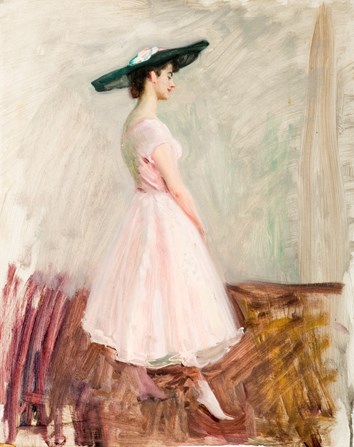WHILE contemporaries broke the plane, revealed the subconscious, and jettisoned representative art’s shackles, Alfred Munnings (1878-1959) made a fortune painting naturalistic landscapes, portraits, and horses. Born a Victorian and living into the atomic age, Munnings used his early training in poster-art lithography to produce eye-catching images at lightning pace. Worldwide, the artist’s works currently number 4000 and counting.
A Barge on the Stour at Dedham, taken from a 1930s series, appeared on Fake or Fortune, on which it was used to authenticate a landscape also featuring Dedham church tower. Completed in 1519, the tower is part of St Mary the Virgin, where Sir Alfred and Lady Munnings were regular worshippers. The Georgian Castle House, home to Munnings for 40 years from 1919, is now the Munnings Art Museum. Horses still graze in surrounding fields, as they did in the artist’s time.
In the museum’s permanent collection St Mary’s is centre stage in Dedham from Lock Cottage (undated), dominating the barge and Stour in the lower section. And, in two paintings titled Stiffkey Church, Norfolk, one canvas has a narrow strip of overcast sky, while the larger and sunnier work depicts an expanse of blue above the church’s low tower and pitched roof.
Grey-day tones attracted the artist. The Ford (1906), shows a rider in brown cap and red kerchief on a chestnut horse, leading white and dark ponies, either side, through water. Munnings observed on its composition: “The grey-weather subject I prepared for was The Ford — grey water reflections broken by lines of the current.”
Colour and Light charts Munnings’s technique from 1890s poster art inspired by Toulouse-Lautrec and Alphonse Mucha, through First World War battlefield sketches and recreations, to studies for portraits including HM The Queen and her racehorse Aureole, with Trainer Captain Cecil Boyde-Rochfort and jockey Eph Smith (c.1956). The portrait shows the late Elizabeth II in pink hat, matching full-skirted pink dress, and mink wrap. A tall figure in morning dress is on the monarch’s right, with the torso of a smaller man behind her right shoulder. The background is grey wash and exposed board, waiting for the landscape to be completed.
 © the estate of sir Alfred munnings, 2021A Study of One of Selfridge’s Young Ladies (1953) by Sir Alfred Munnings
© the estate of sir Alfred munnings, 2021A Study of One of Selfridge’s Young Ladies (1953) by Sir Alfred Munnings
Munnings is considered the greatest British horse artist since George Stubbs. His equine paintings were composed in stages, the rider painted first, then the horse and landscape added. After the Race (1931) uses Munnings’s own horses at models. In A Suffolk Horse Fair, Lavenham (1901), a watercolour study of a Romany horse fair was scaled up in the studio to become a large oil-painting. An unruly circle of horses gather on rough, tufted grass, illustrated through the varied green hues under hoof. A roan colt on the right draws the viewer, with its foreshortened perspective, and flanks and shoulders highlighted in the same beef red as the ribbons braiding its tail. This cream horsehair and red ball is the centre of the canvas.
At the centre of Tagg’s Island (1919), a red nose on a young man, in dark jacket and bow tie, demonstrates the same technique. He is fourth to the right in a post-war celebratory group of six, surrounding a white circular table with three champagne bottles. Overhead is yellow, green, and brown foliage, and there is a crescent of blue Thames to the right.
All works completed after October 1898 were achieved using the sight of one eye, as Munnings’s right eye was blinded by a thorn bush. “Colour and Light” begins with a poster for Colman’s mustard from that year, showing a top-hatted passenger dousing a white carriage horse in mustard powder, the yellow of the condiment echoed in the wheels and base of the carriage.
Between 1953 and 1956, Munnings painted Does the Subject Matter?, placing a Selfridges model in pink dress and wide hat, in a circle of bespectacled caricature men, at a gallery with pastiche Picassos. Munnings wanted to emphasise traditional painting’s superiority. Popular with wealthy clients since his Canadian Cavalry battlefield art, commanding fees of £500 for works completed in days, Munnings questioned modern art from a place of talent and prestige.
“Munnings: Colour and Light” is at the Munnings Art Museum, Castle Hill, Dedham, Colchester, Essex, until 22 October. Phone 01206 322127. www.munningsmuseum.org.uk